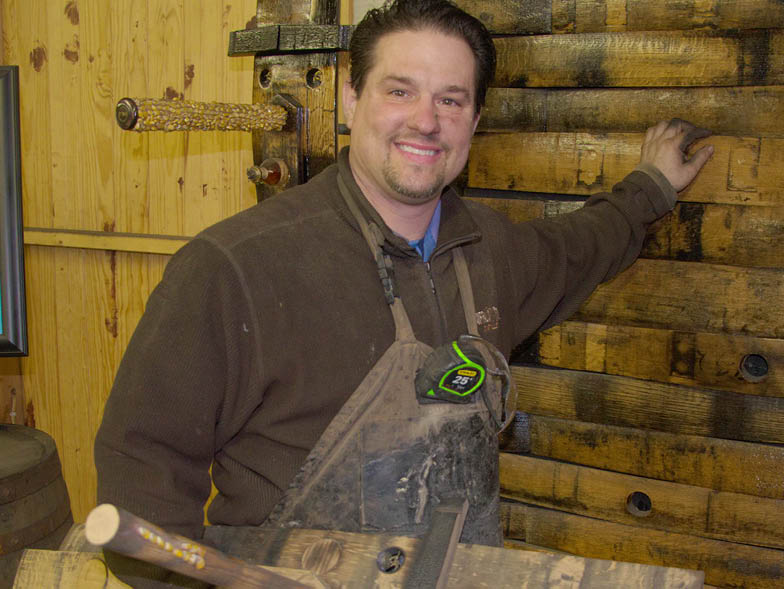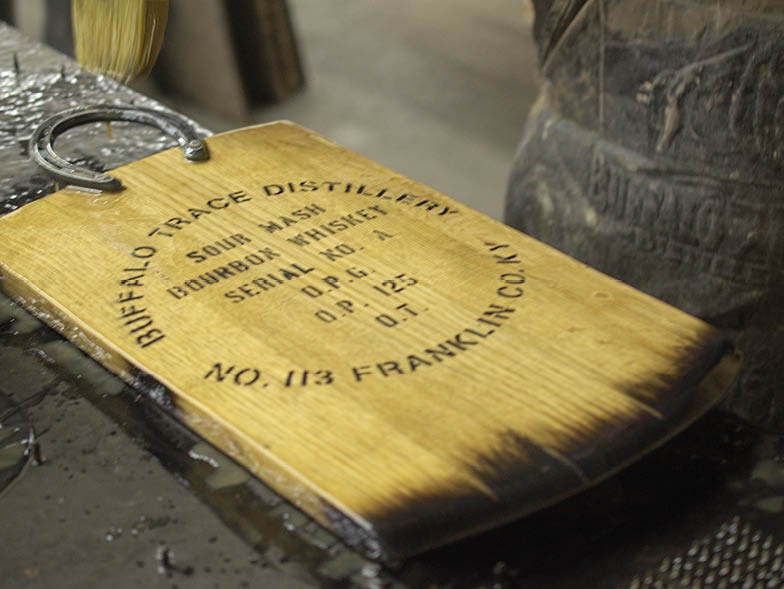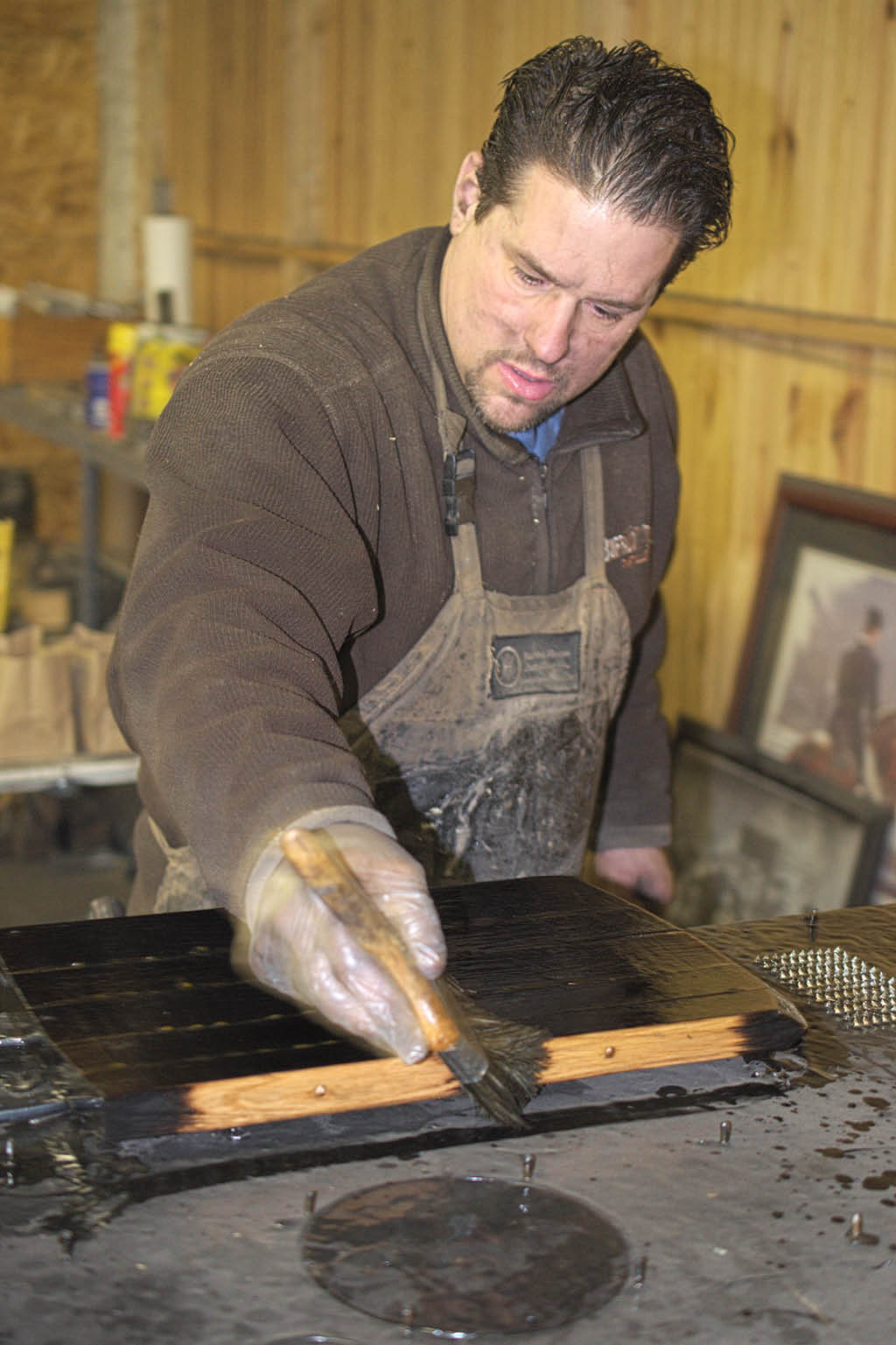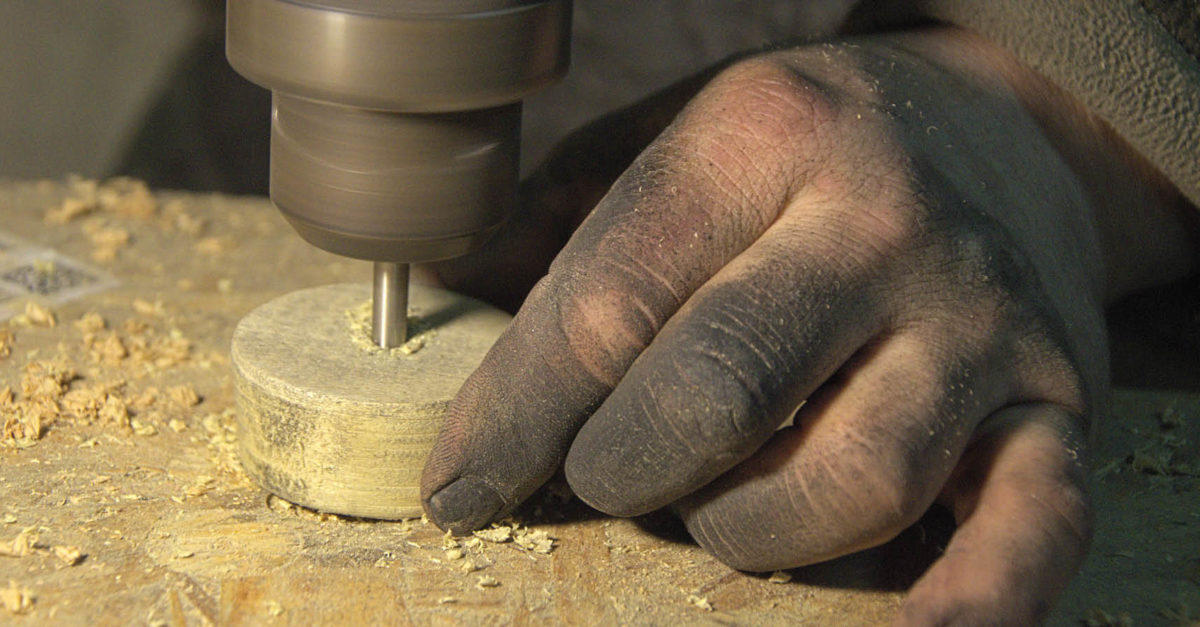Bourbon With a Twist: The Art of Salvaging Oak
As the staves fall to the floor, the traditional charred interior is revealed and generates a blanket of soot throughout Tony’s Studio 300 in the old James Pepper Distillery in Lexington, Kentucky.
The master distiller eyes the chard oak barrels carefully year after year, anticipating just the right maturity to produce the full essence and classic amber tone of top-shelf bourbon. Craftsman Tony Davis has his eyes on those same barrels, but not for the bourbon. Tony seeks the perfectly seasoned wood barrels to succumb to his creative hands. The salvaged oak is crafted into functional art pieces for the home, such as cutting boards, lazy Susans, and art easels.
His unique designs start with the staves, the curved wood planks of the barrel that are bound tightly with metal bands. A grinder quickly relieves the tension of the band, freeing the pieces of white oak. As the staves fall to the floor, the traditional charred interior is revealed. The grinding generates a blanket of soot throughout Tony’s Studio 300 in the old James Pepper Distillery in Lexington, Kentucky.

The very first staves that Tony Davis reclaimed from a bourbon barrel were not in his pursuit of crafting in Studio 300, but many years before when he was young and simply passing time in the Lexington, Kentucky, summers. The walls of Tony’s childhood clubhouse were fortified with small wood planks pulled from trash cans behind a neighborhood store. Those discarded remnants were actually from bourbon barrels that had already been repurposed once as planters. “Little did I know I would be doing what I am doing now,” Tony reflects.
From the little clubhouse and his humble beginnings in Lexington, Tony would take a remarkable journey before picking up another piece of charred white oak from a bourbon barrel. Struggling to complete a formal education beyond the seventh grade, Tony started delivering papers and working at a fast food restaurant. In 1995, Tony joined the United States Marine Corps, which would take him to eighteen countries around the world. He put his mind to studying and earned a GED, the equivalent of a high school diploma. “I always wanted to do better for myself because of where I came from,” Tony conveyed. “If it were not for the Marine Corps, I would not be where I am today.
“The Marine Corps taught me discipline, integrity, and to be honest. It taught me everything. I can never repay the Marine Corps for all they did for me,” Tony shared. “I hold them close to my heart.
Tony also has the USMC to thank for indirectly introducing him to the art of repurposing barrels. During the time he was briefly stationed at Camp Pendleton in California, Tony enjoyed Fleet Week, including a tour of nearby Napa Valley wine country where he stumbled upon artisans crafting wine racks and decorative art pieces from the wine barrels.
Tony tucked the experience into his memory while he was still busy serving his country, but found himself recalling the Napa Valley artwork during his occasional visits back home to the Bluegrass Region of Kentucky, when the mere sight of old bourbon barrels sent him down memory lane. Creative ideas were subtly starting to form.

Tony’s journey came full circle as he eventually landed back in Lexington after his service in the Marines. With the memory of the artisans still etched in his mind, he found himself frequently in his backyard barn, crafting wine racks and art easels from old pieces of hand-hewn boards, but had dreams of one day creating something proprietary.
Tony’s moment of creative genius came while he was stuck in traffic in downtown Lexington, sitting in his truck looking at a sign for the 2010 Alltech FEI World Equestrian Games. The World Equestrian Games would be held in Tony’s hometown, the first time the International Federation for Equestrian Sports would host the elite event at a venue outside of Europe. An idea illuminated. “I pondered what I could do for Kentucky that we already had that I could put a twist on,” recounted Tony, as he wanted others to share in his enthusiasm for Kentucky. The inspiration for an art piece was kindled.
Returning home, he grabbed an old bourbon barrel that he had purchased at a garage sale some years earlier for no specific purpose. With newfound resolution, he cut the metal bands with his grinder, and the staves fell to the ground. As he was picking them up, he saw what could be made into a body and immediately knew. Kentucky Knows was in its infancy and would gradually develop into his signature art piece and registered trademark, as a slightly abstract character crafted to illustrate unique aspects of Kentucky.
He refined his vision with extensive research into the history of Kentucky, the bourbon industry, and horse racing. “Kentucky Knows represents the icons of Kentucky,” Tony conveyed as he proudly spoke of his home state.
The body of Kentucky Knows is, of course, staves from a bourbon barrel. The long corn “Knows”, a homonym play on nose, represents the required minimum 51 percent corn content in bourbon. The Commonwealth of Kentucky joined fourteen other states in the recently formed Union in 1792, and that date rests prominently on the end of the corn nose.

The eyes are a story of their own. The little thoroughbreds sitting in the eyes are reclaimed bourbon bottle toppers from Blanton’s Single Barrel Bourbon. The eyes of Kentucky Knows are always facing to the left. (Anywhere horses race in the world, they gallop counterclockwise, thus the same for the horses that form the eyes of Kentucky Knows.) Tony adds, “Kentucky Knows has visions of a thoroughbred.
“He’s always been inside the bourbon barrel; it just took us to let him out,” Tony said in a nearly serious tone. Tony’s entrepreneurial drive was now inspired and in high gear. He wanted to use the bourbon barrels to create marketable items that would appeal to a wide audience, which led him to a cutting board. Tony crafts all sorts of items from the staves of the bourbon barrel, but cutting boards are the foundation of the business. Initially there were several unsuccessful attempts to market the boards. But with his eternally pensive analysis, Tony said, “I have learned just as much from a no, as I have from a yes.”
The cutting boards are made from the head of the barrel; the individual pieces of wood are separated and then glued back together to ensure a solid working surface. The original distillery stamp along with artful charring added by Tony are thoroughly sealed with shellac approved by the Food and Drug Administration for use in the kitchen. Some of his cutting boards are occasionally used to slice and dice, while many others simply remain hanging on the wall as decor.
With the cutting boards fully crafted, he landed an interview with Brad Williams, Director of Merchandising for Liquor Barn, a chain of full service party stores. Tony remembers that day clearly: August 10, 2011. Tony and his four cutting boards made quite an impression, and a relationship was sparked. The first sixteen cutting boards he provided to Liquor Barn’s stores in the Hamburg area of Lexington sold out in the first week.

Kentucky Knows and cutting boards are not the only creations that have emerged from the bourbon barrels in Tony’s studio. There’s also a Bits-n-Barrel lazy Susan, a Shoes-n-Barrel lazy Susan, easels, bottle openers, and the latest addition, Grill-n-Char. In his optimistic manner, Tony said, “This little business has brought out the good in me. In my studio, I am able to be who I want to be as long as I do what’s right. It’s still a small business, but it’s really big to me.”
Back at the distillery, each barrel is deeply toasted and receives a light charring before the bourbon begins the aging process. Once Tony frees the thirty-two or thirty-three staves from the ringed barrels, the first task is to scrape down that charred surface. The black soot seems to get nearly everywhere, even on Tony’s face. The little pieces of burnt white oak that have been soaked in bourbon for many years, generate a unique flavor when smoked in a grill.
The bourbon barrel char delivers a flavor suited for all sorts of meats, fruits and vegetables, and nearly anything you can put on the grill. About eight ounces of the char is placed on a foil tray and heated among the charcoal. Just before the cooking begins, splash a little apple juice on the char, and the grill is filled with a twist of traditional Kentucky flavor. All of these handcrafted creations require a lot of bourbon, or rather the barrels that once held all that bourbon. Bourbon barrels are not necessarily easy to obtain, especially to use those with logos and propriety markings in a business venture.
Tony has forged a relationship with Buffalo Trace Distillery in Franklin County, Kentucky. In his humble manner, Tony has always requested permission from Buffalo Trace prior to using their brand in any of his handcrafted items. Over the years, Tony has gained permission to use even the most coveted brands in the Buffalo Trace family, such as Elmer T. Lee and Blanton’s Single Barrel.
Every item remains crafted and personally judged by Tony before it goes to market. Well over a thousand, and possibly over two thousand, bourbon barrels will pass through his studio in Lexington this year. Nearly every one of those barrels will be from Buffalo Trace Distillery, based on a relationship that he treasures.

“How was I ever so blessed to work with these great labels?” Tony wonders aloud. “The people make the brand; the brand does not make the people.”
In the retired James Pepper Distillery, Tony can be found seven days a week pouring his passion into the oak barrels, surrounded by barrels, staves, heads, rings, sawdust, and soot. Elmer T. Lee, a legendary bourbon craftsman and longtime Master Distiller for Buffalo Trace, once walked the very same concrete floors as a production manager for the James Pepper Distillery, which was owned by Schenley Products, predecessors to the present day Buffalo Trace.
“I am promoting self-worth, not the bourbon,” Tony states thoughtfully.
The artisan in Tony is often overshadowed by his motivation to succeed, but his terms of success are certainly not measured simply by how many cutting boards he sells. It is apparent that Tony reflects on the path his life has followed, and provides insightful glimpses into his desire to be a cornerstone of inspiration for children, especially those that are struggling.
A photo of Tony when he was about ten years old in the kitchen of his childhood home, with his mother and two brothers, is front and center in his workshop. He shares how his clothes were provided by Catholic Charities of Lexington, and speaks of opportunities that were not readily available to him. It serves as a reminder of where he started. “Nobody in my family has ever graduated high school to this day,” Tony shared. “I find it hard to believe I made it out of there. It’s what you do with yourself that creates the story.”

Tony’s future goals are not founded in productivity, efficiency, or dollars. “I see myself as a community servant,” Tony declared. “Inspiring kids to do the right thing because what you do today will follow you. You can’t let the wrong thing inspire you.”
The desire to give back to his hometown is a constant thread in Tony’s conversation. “I want to be able to give back to the community,” Tony said. “Go into the inner city of Lexington, and show those kids to put heart into what they do and to stay honest. They can do what I did; I came from there.”
According to Tony, “It takes a lifetime to master your own life. Looking back on it, I’m starting to understand myself and my life. I know how I did it. It was passion.”
For more info, visit www.kentuckyknows.com.























